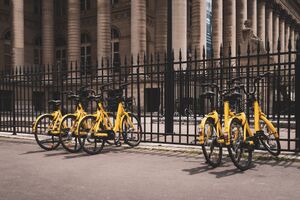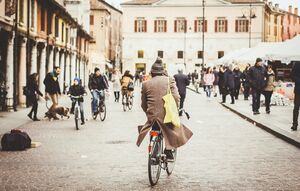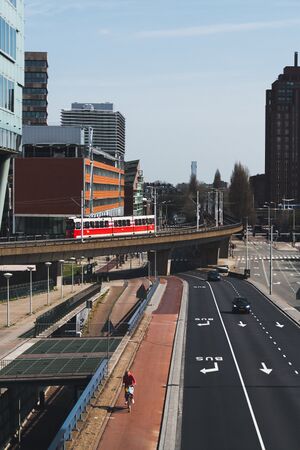Cycling: Active Transport: Difference between revisions
No edit summary |
No edit summary |
||
| Line 8: | Line 8: | ||
[[Active Transportation and Planetary Health|Active transport]] relates to physical activity undertaken as a means of transport. It includes travel by foot, bicycle and other non-motorised vehicles<ref>Diabetes Australia Walk to Work Available:https://www.walk.com.au/wtw/Page.asp?PageID=1265 (accessed 18.12.2021)</ref>. | [[Active Transportation and Planetary Health|Active transport]] relates to physical activity undertaken as a means of transport. It includes travel by foot, bicycle and other non-motorised vehicles<ref>Diabetes Australia Walk to Work Available:https://www.walk.com.au/wtw/Page.asp?PageID=1265 (accessed 18.12.2021)</ref>. | ||
Cycling is | Cycling is a low-carbon modes of transport that enhance urban quality and facilitate social fabric. It is also a cheap, flexible, personal mode of transport<ref name=":0">UN Cycling, the better mode of transport Available: https://www.unep.org/news-and-stories/story/cycling-better-mode-transport (accessed 18.12.2021)</ref>. | ||
While cycling is among the greenest ways to travel, replacing cars with bikes would have many other benefits. These include: cutting congestion; addressing health problems associated with sedentary lifestyles; increasing life expectancy; cutting particulate air pollution | While cycling is among the greenest ways to travel, replacing cars with bikes would have many other benefits. These include: cutting congestion; addressing health problems associated with sedentary lifestyles; increasing life expectancy; cutting particulate air pollution (a problem which shortens global life expectancy by an average of 1.8 years according to one study), and has also been linked to an increased [[Coronavirus Disease (COVID-19)|COVID-19]] death rate<ref name=":0" />. | ||
== Bike-share == | == Bike-share == | ||
| Line 32: | Line 32: | ||
== Sub Heading 3 == | == Sub Heading 3 == | ||
From a climate perspective, it makes sense for as many journeys as possible to be made by bike. However on a national scale, cycling has a limited role in addressing climate change. Because cycling is restricted to short journeys for most people, it can only replace a small fraction of the kilometres covered by cars. | |||
* Even if half of all <8 km car journeys were replaced with cycling this would save around 7.7-million tons CO2e in the UK, equivalent to 2 per cent of UK domestic emissions in 2016. | |||
* Ebikes could boost the uptake of cycling to some extent. | |||
* Countries with the highest cycling rates are flat (Denmark and the Netherlands)<ref name=":0" />. | |||
== Resources == | == Resources == | ||
Revision as of 06:23, 18 December 2021
Original Editor - User Name
Top Contributors - Lucinda hampton and Kim Jackson
Introduction[edit | edit source]
Active transport relates to physical activity undertaken as a means of transport. It includes travel by foot, bicycle and other non-motorised vehicles[1].
Cycling is a low-carbon modes of transport that enhance urban quality and facilitate social fabric. It is also a cheap, flexible, personal mode of transport[2].
While cycling is among the greenest ways to travel, replacing cars with bikes would have many other benefits. These include: cutting congestion; addressing health problems associated with sedentary lifestyles; increasing life expectancy; cutting particulate air pollution (a problem which shortens global life expectancy by an average of 1.8 years according to one study), and has also been linked to an increased COVID-19 death rate[2].
[edit | edit source]
The Institute for Transportation and Development Policy’s bikeshare planning guide reports that today, more than 600 cities worldwide have their own bike-share systems, and more programmes are starting every year. The largest systems are in China, in cities such as Hangzhou and Shanghai. In Paris, London and Washington, D.C., highly successful systems have helped to promote cycling as a viable and valued transport option.[2]
Health[edit | edit source]
Cycling has become popular for a variety of reasons. It helps to reduce the risk of diabetes, some forms of cancer, cardiovascular diseases and depression. Research from the United Kingdom found that cycling to work is linked with a 45 per cent lower risk of developing cancer, and a 46 per cent lower risk of cardiovascular disease, compared to commuting by car or public transport.
The health benefits of cycling daily rather than taking a car for short trips outweigh the risks of inhalation of air pollutants. Daily exercise prolongs life expectancy by approximately 3.4 years whereas inhalation of polluted air reduces life expectancy by 1 to 40 days. Regular cycling boosts physical fitness and is an efficient way to prevent obesity[2].
Green Transport[edit | edit source]
Cycling has a carbon footprint of about 21g of CO2 per kilometre (less than walking or getting the bus and less than a tenth the emissions of driving).
- About three-quarters of cycling’s greenhouse gas emissions occur when producing the extra food required to “fuel” cycling, while the rest comes from manufacturing the bicycle
- Electric bikes have an even lower carbon footprint than conventional bikes because fewer calories are burned per kilometre, despite the emissions from battery manufacturing and electricity use
If cycling’s popularity in Britain increased six-fold (equivalent to returning to 1940s levels) and all this pedalling replaced driving, this could make a net reduction of 7.7-million tons of CO2 annually, equivalent to 6% of the UK’s transport emissions.[3]
Sub Heading 3[edit | edit source]
From a climate perspective, it makes sense for as many journeys as possible to be made by bike. However on a national scale, cycling has a limited role in addressing climate change. Because cycling is restricted to short journeys for most people, it can only replace a small fraction of the kilometres covered by cars.
- Even if half of all <8 km car journeys were replaced with cycling this would save around 7.7-million tons CO2e in the UK, equivalent to 2 per cent of UK domestic emissions in 2016.
- Ebikes could boost the uptake of cycling to some extent.
- Countries with the highest cycling rates are flat (Denmark and the Netherlands)[2].
Resources[edit | edit source]
- bulleted list
- x
or
- numbered list
- x
References[edit | edit source]
- ↑ Diabetes Australia Walk to Work Available:https://www.walk.com.au/wtw/Page.asp?PageID=1265 (accessed 18.12.2021)
- ↑ 2.0 2.1 2.2 2.3 2.4 UN Cycling, the better mode of transport Available: https://www.unep.org/news-and-stories/story/cycling-better-mode-transport (accessed 18.12.2021)
- ↑ Bike radar Available: Cycling environmental impact Available:https://www.bikeradar.com/features/long-reads/cycling-environmental-impact/ (accessed 18.12.2021)










